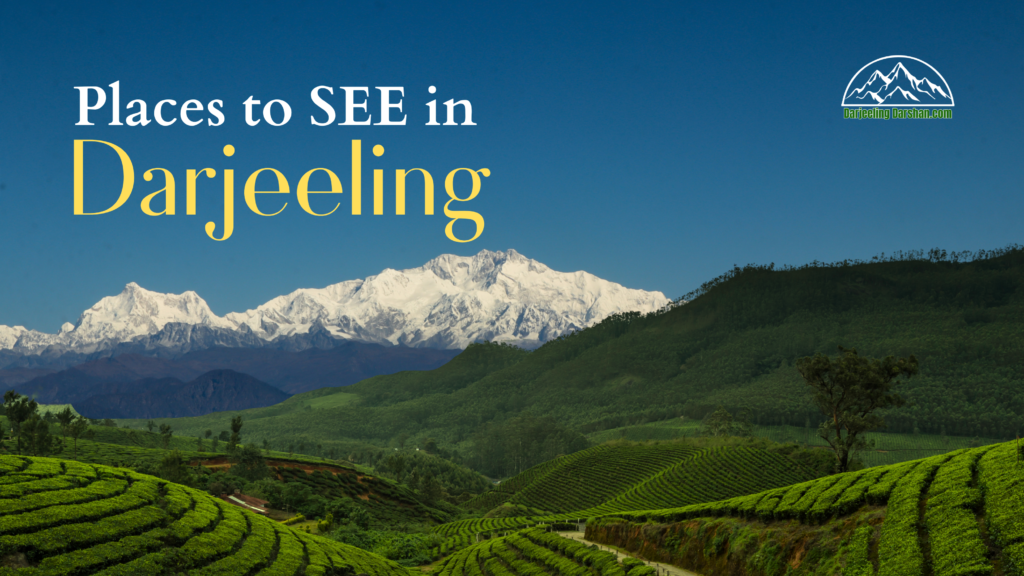
Darjeeling’s tourist spots showcase India’s most breathtaking views, especially Tiger Hill with its stunning sunrise vistas of Mount Kanchenjunga, the world’s third highest peak. At the time I first saw these majestic mountains peek through the morning mist, and more places to see in Darjeeling, I was truly speechless. This charming hill station in West Bengal fascinates visitors with its perfect mix of peaceful tea gardens, cultural landmarks, and natural beauty.
The historic Darjeeling Himalayan Railway, lovingly called the “Toy Train,” draws nearly half a million tourists each year. Visitors can spot rare red pandas at the Padmaja Naidu Himalayan Zoological Park, making each moment feel special. The region’s 80-plus tea plantations spread across 17,500 hectares create a paradise for tea lovers and photographers.
Batasia Loop’s architectural beauty features a war memorial honoring Gorkha soldiers, while the serene Japanese Peace Pagoda promotes harmony among visitors. The area also offers thrilling activities like paragliding, mountain biking, trekking, and rafting on the Teesta River. The Himalayan Mountaineering Institute, 69 years old and ranked among the world’s top mountaineering schools, shows Darjeeling’s deep connection to adventure sports.
Tiger Hill: A Sunrise That Redefined Beauty

Tiger Hill sits 2,590 meters (8,500 ft) above sea level and ranks as the brightest star among Darjeeling’s scenic spots. Nature lovers and photographers will find this iconic summit offers a unique experience that surpasses regular tourism with a sunrise so beautiful it has earned legendary status across India and beyond.
Why Tiger Hill’s the most visited place in Darjeeling
Tiger Hill’s magic comes from its stunning panoramic views of the mighty Himalayan range. Clear mornings reward visitors with an amazing sight—Mount Everest (8,848 meters), Makalu (8,481 meters), and Lhotse (8,516 meters) visible on the far horizon. The real showstopper here is the breathtaking view of Kanchenjunga, which stands as the world’s third highest mountain.
Something amazing happens at sunrise. Kanchenjunga’s peaks light up with golden rays while darkness still covers the lower slopes. This creates an otherworldly scene as the snow-covered peaks seem to float above the clouds, bathed in shades of pink, orange, and gold. Mount Everest might be the world’s highest peak, but it looks shorter than Kanchenjunga from here—a trick of perspective since Kanchenjunga stands just 107 miles (172 km) from Tiger Hill.
Visitors can spot Kurseong to the south and watch several rivers including Teesta, Mahananda, Balason, and Mechi as they wind through the landscape. This complete view explains why hundreds of tourists don’t mind braving the early morning cold each day during peak season.

Best time to visit Tiger Hill’s and how to get there
The most amazing views come between October to December or February to April. These months usually bring clear skies and the best visibility of the Himalayan range. Many photographers choose winter despite the cold because the air stays exceptionally clear.
You’ll need an early start to catch the famous sunrise. Most tours leave Darjeeling town between 3:30 AM and 4:15 AM (a bit later in winter) to reach Tiger Hill by dawn. The trip covers about 11 kilometers and takes 30-45 minutes by car.
You can reach this premier Darjeeling attraction several ways. Most people hire a taxi or join a shared jeep from Darjeeling town. Another option takes you to Ghoom station on the Darjeeling Himalayan Railway, followed by a 40-minute uphill journey. The adventurous types can hike to Tiger Hill, which takes about 2-3 hours through routes via Chowrasta, Alubari, or Jorebangla.
Since September 2019, authorities limit daily vehicles at Tiger Hill. Book your transportation at least a day ahead. The site doesn’t allow self-driven private and rental cars.
Tips to avoid the early morning crowd for Tiger Hill’s
Tiger Hill’s popularity can lead to big crowds, especially during tourist season. Here’s how to make the most of your visit:
- Pick weekdays instead of weekends to enjoy a quieter viewing experience.
- Get there extra early (around 4:00-4:30 AM) to grab the best viewing spots before crowds arrive.
- Reserve your ride a day before since taxis get limited daily coupons first-come, first-served.
- Be ready for a short walk from parking to the viewing point, especially during busy times when cars park further away.
- Time your visit during shoulder seasons (early October or late April) when crowds thin out but views stay spectacular.
Note that Darjeeling’s weather can be unpredictable. Some visitors wait without seeing anything as thick clouds block the view. In spite of that, the experience proves worthwhile—as one visitor put it, “When the sun finally rose, the golden light slowly showed the snow-clad mountains—it felt like witnessing magic”.
Wear enough warm clothes, especially in winter when temperatures drop below freezing. Multiple layers, gloves, and a warm hat help you focus on the stunning views rather than feeling cold.
Your Tiger Hill morning isn’t complete without stopping at nearby Batasia Loop where stalls serve hot samosas—the perfect warm treat after an early mountain adventure.
Batasia Loop and the Toy Train Experience
The Batasia Loop stands as another engineering wonder right after you experience the sunrise magic at Tiger Hill. This remarkable spiral railway track sits just 5 kilometers from Darjeeling town. It’s a perfect mix of history, architectural brilliance, and scenic beauty that shows what makes Darjeeling’s tourist spots special.
The engineering marvel of the loop
The Batasia Loop came to life in 1919 as a clever solution to a tough terrain problem. The Darjeeling Himalayan Railway (DHR) engineers needed a way to handle the steep drop between Ghoom (India’s highest railway station at 7,407 feet) and Darjeeling town. Their answer was this amazing spiral track that made the descent gentler.
The train makes a complete circle around the loop and drops about 1,000 feet in altitude. This spiral design helps the train stay stable on what would be a dangerous slope. The Batasia Loop remains one of DHR’s most impressive features. The colonial-era engineering still works perfectly after more than 100 years.
You’ll see stunning views of Darjeeling town from the loop. The snow-capped Himalayan peaks create a perfect backdrop, with Mount Kanchenjunga standing tall. The name “Batasia” means “airy space” – a perfect description of this scenic spot.
Gorkha War Memorial and its significance
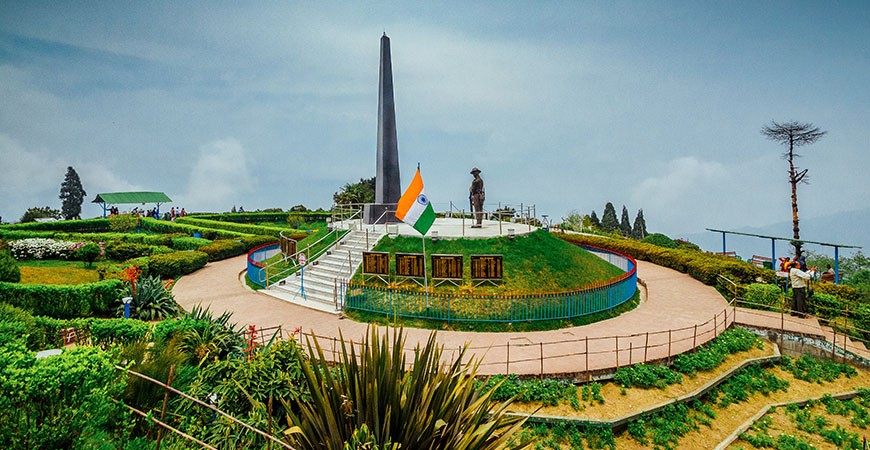
The loop’s center holds another important attraction – the Gorkha War Memorial. This memorial opened on March 22, 1995, and honors brave Gorkha soldiers who died protecting India since independence.
A 30-foot high triangular granite cenotaph dominates the memorial. Its base has a Roll of Honor listing fallen soldiers’ names and dates. Next to it stands a 9-foot bronze statue of a Gorkha soldier created by famous sculptor Gautam Pal. More than 75 Gorkha soldiers from Darjeeling’s hills have died in various operations and wars since India’s independence. This makes the memorial deeply meaningful to locals.
The memorial grounds cover about 50,000 square feet inside the Batasia Loop. Beautiful gardens with seasonal and year-round flowers surround the monument. This mix of solemn tribute and natural beauty creates a moving experience for visitors.
Riding the Darjeeling Himalayan Railway
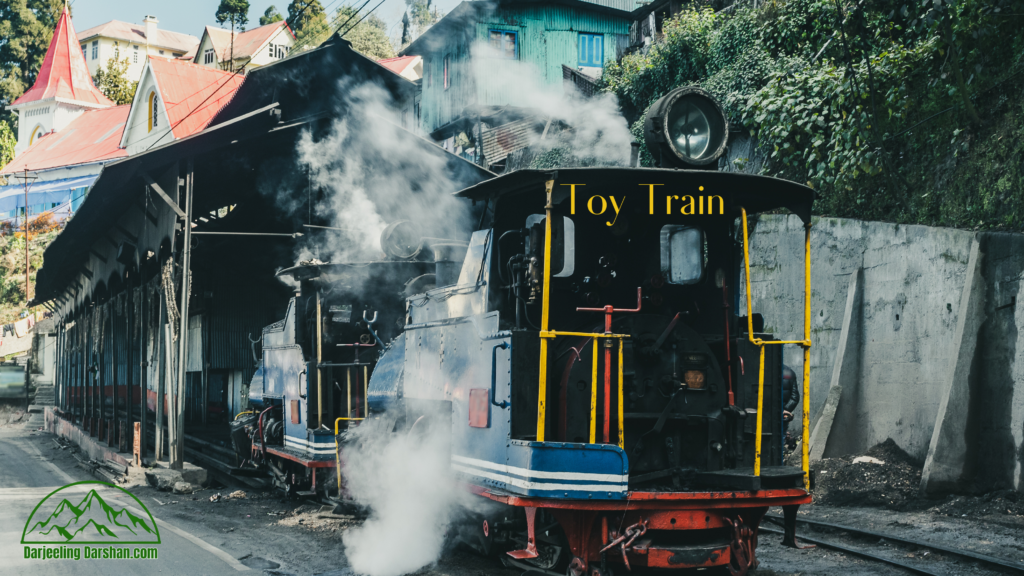
The “Toy Train” of the Darjeeling Himalayan Railway takes you back in time. This narrow-gage railway (2 ft/610 mm) was built between 1879 and 1881. UNESCO recognized it as a World Heritage site on December 2, 1999.
The full DHR route runs about 88 kilometers from New Jalpaiguri to Darjeeling. It climbs from 328 feet to 7,218 feet above sea level using six zigzags and five loops. The current operating section between Kurseong and Darjeeling takes about 3 hours.
Short on time? Try these ride options:
- Darjeeling-Ghoom-Darjeeling Loop: This popular route lets you stop at the Batasia Loop for 10 minutes to see the War Memorial.
- Steam-hauled Red Panda service: Runs from Darjeeling to Kurseong for a genuine historical experience.
- Special steam-enthusiast trains: Run by vintage British-built B-Class locomotives.
The Batasia Loop welcomes visitors daily from 6 AM to 5 PM. Entry costs 20 rupees per person, but toy train ticket holders get in free.
The magic of this trip lies in sharing the same journey that travelers took over a century ago. As the train curves gently around the Batasia Loop, you’re not just seeing an engineering marvel – you’re part of a living history that still amazes people from around the world.
Peace Pagoda and Mahakal Temple: Spiritual Calm in the Hills
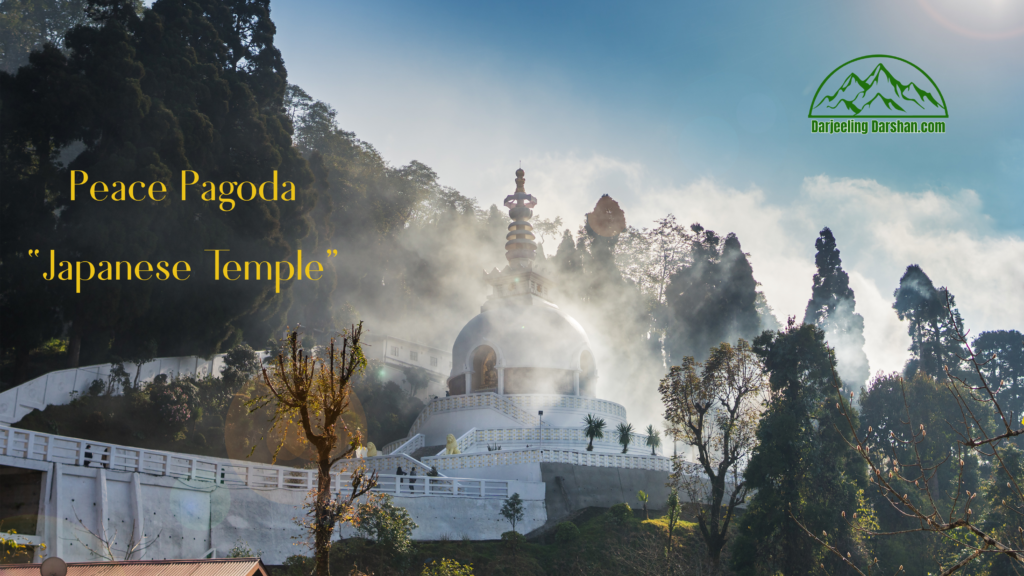
Beyond the natural wonders and engineering marvels, Darjeeling’s spiritual sites are peaceful retreats away from busy tourist centers. The Japanese Peace Pagoda and Mahakal Temple are among the most serene places to see in Darjeeling. Each site tells its own story of religious harmony and cultural fusion that shaped this Himalayan town’s identity.
The story behind the Japanese Peace Pagoda
The Peace Pagoda (or Shanti Stupa) stands gleaming white against the emerald hillside. Japanese Buddhist monk Nichidatsu Fujii, founder of the Nipponzan-Myōhōji Buddhist Order, guided its construction. He met Mahatma Gandhi in 1931 and dedicated his life to promoting global peace and non-violence. The foundation stone was laid on November 3, 1972, and the pagoda opened its doors on November 1, 1992.
This architectural marvel sits on Jalapahar Hill’s slopes, reaching 28.5 meters high with a 23-meter diameter. Four golden-polished Buddha statues decorate the pagoda’s walls. These statues represent different avatars and stages of Buddha’s life. M. Ohka designed the structure, which took 36 months to build.
This Darjeeling attraction connects to a bigger story. Fujii saw the destruction of Hiroshima and Nagasaki and started building Peace Pagodas worldwide as symbols of harmony. The first Japanese pagoda came up in Kumamoto in 1954.
Visitors can join daily prayers from 4:30-6:00 AM and 4:30-6:30 PM. They’ll hear authentic Buddhist chanting while monks beat large drums called Ho-Ko. The place stays peaceful even outside prayer hours.
Mahakal Temple: Where Hinduism and Buddhism meet
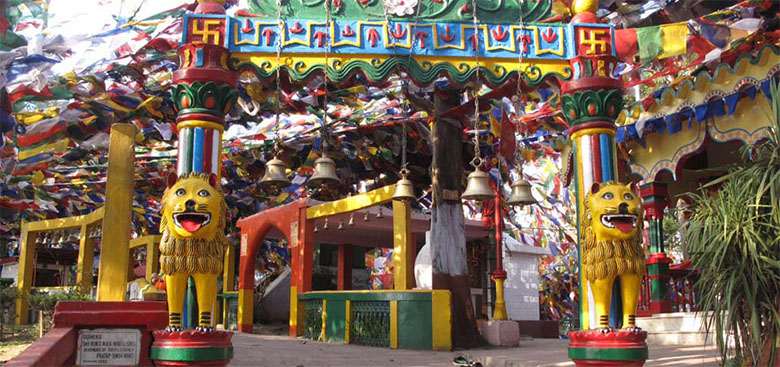
Mahakal Temple sits at Observatory Hill’s summit. It’s a special place where Hindu priests and Buddhist monks pray together. This sacred spot shows the cultural harmony that makes Darjeeling unique.
The temple’s story is fascinating. A Buddhist monastery called “Dorje-Ling” (place of thunder) stood here first. Lama Dorjey Rinzing built it in 1765. A Gorkha invasion around 1788 destroyed the monastery. Stories say three Shiva-Lingas appeared at the site in 1782, representing Brahma, Vishnu, and Maheshwar (Shiva).
Today, the main temple has these three gold-plated lingams next to Buddha statues. Hindu rituals and Buddhist practices happen here at the same time. The complex has many smaller shrines for deities like Kali, Durga, Ganesha, and Hanuman. A white ‘chorten’ (Tibetan memorial shrine) holds Dorjey Rinzing Lama’s relics, showing this spiritual mix.
Panoramic views from Observatory Hill
Observatory Hill rises above Chowrasta square (the Mall to locals) and offers stunning views. Clear days reveal majestic Mount Kanchenjunga against blue skies. Twelve other peaks, all above 20,000 feet, complete this spectacular scene.
October and November bring the clearest skies for panoramic views. The climb to Mahakal Temple takes you through fluttering prayer flags and ringing bells that create a spiritual atmosphere.
Early morning visits work best for photographers and nature lovers. The hill’s unique Himalayan plants and animals add natural beauty to this spiritual spot.
These spiritual sanctuaries are must-see places in Darjeeling. They’re important not just for their religious value but also because they show cultural harmony. The breathtaking mountain views leave visitors feeling peaceful and refreshed.
Wildlife and Adventure at Padmaja Naidu Zoo and HMI

Wildlife enthusiasts consider the conservation efforts at Padmaja Naidu Himalayan Zoological Park one of the most important places to see in Darjeeling. This highest-altitude zoological park in India sits at 2,150 meters (7,050 feet) and has gained worldwide recognition for its breeding programs and conservation work.
Red pandas and snow leopards in their natural habitat
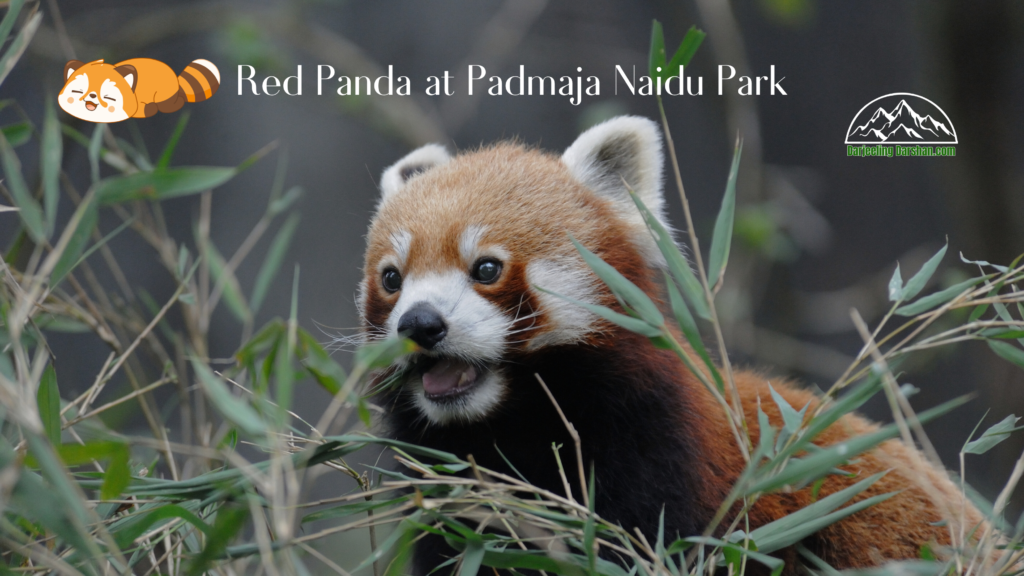
The park’s snow leopard conservation breeding program has seen incredible results. Since 1983, the park has welcomed 81 snow leopard births, making it second only to New York’s Bronx Zoo’s 80 cubs since the 1960s. The zoo now houses 14 snow leopards (7 males and 7 females) – the world’s largest captive population of these mysterious cats.
Breeding wild cats in captivity comes with unique challenges. Snow leopards tend to be shy, prefer solitude, and often show aggression toward others of the same sex. The zoo has tackled this by creating special enclosures that feel like home to these cats, complete with terraced slopes, resting platforms, and rocky surfaces.
The red panda program started in 1986 with just four animals – one male and three females. Today, it has grown to 21 red pandas. The program celebrated a huge win when nine captive-bred red pandas found their way back to freedom in Singalila National Park between 2022 and 2024. Three females have already given birth to five cubs in the wild.
Himalayan Mountaineering Institute and its legacy
Next to the zoo stands the prestigious Himalayan Mountaineering Institute (HMI). India’s first Prime Minister, Jawaharlal Nehru, founded it on November 4, 1954. The institute honors the first successful climb of Mount Everest by Tenzing Norgay and Sir Edmund Hillary.
Mountain climbing enthusiasts see HMI as sacred ground. Tenzing Norgay led the institute’s field training from 1954 to 1976. Over its 70-year history, HMI has shaped more than 50,000 students, including 5,000 from other countries.
HMI’s facilities impress visitors with an indoor climbing wall, outdoor training areas, and a library containing over 2,800 books about mountaineering, travel, exploration, geology, and wildlife. The institute also houses India’s oldest mountaineering museum, which opened in 1957. Here, you’ll find models, equipment, photographs, and memories from famous climbing expeditions.
Adventure activities for thrill-seekers in Darjeeling
Darjeeling gives adventure lovers many chances to get close to nature. Singalila National Park lets visitors join guided treks to spot red pandas in their natural home. Seeing these fox-like creatures with their ringed tails ranks among the area’s most treasured wildlife encounters.
Rhododendron-filled landscapes create perfect backgrounds for wildlife photography and bird watching. You’ll often spot laughing thrushes, red crossbills, flycatchers, and sunbirds. Most people start their trip from Manebhanjan, riding in restored Landys (Land Rovers) into the national park.
Conservation work has paid off. Singalila National Park and Neora Valley National Park now support thriving red panda populations. Recent counts show 38 red pandas in Singalila and 32 in Neora Valley, giving wildlife lovers real chances to spot these rare animals.
The Padmaja Naidu Himalayan Zoological Park broke new ground in March 2024. It became India’s first zoo to create a genetic biobank that saves DNA samples from wildlife found only in snowy regions. This special facility keeps genetic material from endangered species safe in liquid nitrogen at freezing temperatures, protecting their legacy for future generations.
These Darjeeling attractions blend education with adventure. Visitors learn about conservation challenges while meeting some of the world’s most fascinating Himalayan species.
Tea Gardens and Ropeways: Darjeeling’s hidden Place to See
A trip to Darjeeling remains incomplete without exploring its lush tea gardens and aerial ropeway. These iconic attractions give visitors a perfect blend of colonial heritage and natural beauty that made this hill station famous worldwide.
Happy Valley Tea Estate: A walk through history
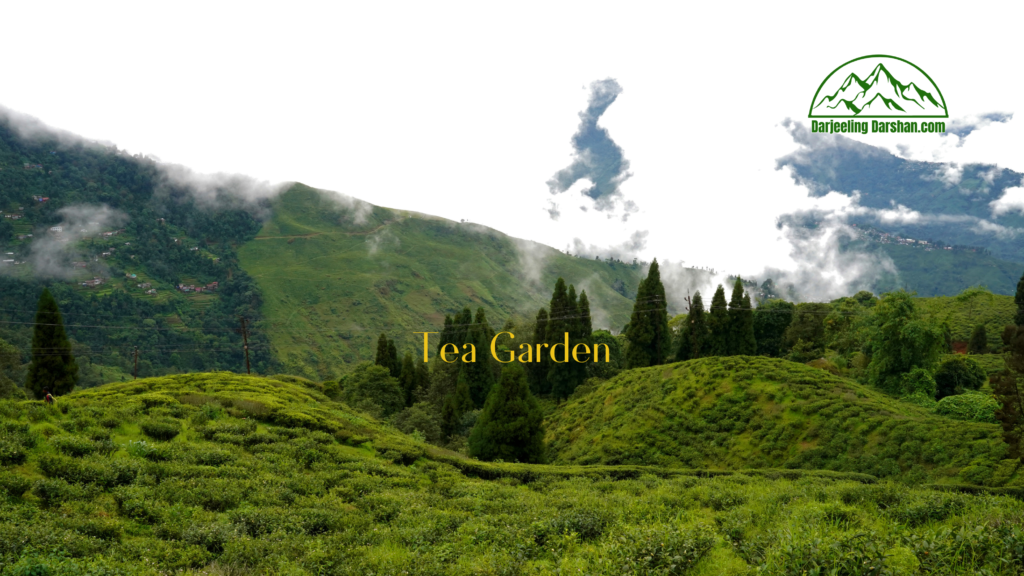
The 169-year-old Happy Valley Tea Estate stands among India’s oldest and highest tea gardens at 6,400 feet elevation. This second oldest tea estate in Darjeeling, previously known as Wilson Tea Estate, covers 437 acres of green slopes. The garden’s location makes it special – just a 15-minute walk from the town center.
The estate yields about 100,000 kilograms of premium organic Darjeeling tea each year. Visitors can join guided tours through the well-kept gardens where workers skillfully hand-pick delicate tea leaves. The tours show you the complete tea processing journey – from withering and rolling to oxidation and sorting.
Darjeeling Ropeway: Floating above the valleys

The Rangeet Valley Passenger Cable Car, known locally as the Darjeeling Ropeway, treats visitors to stunning panoramic views on its 5-kilometer route. This 55-year-old aerial tramway links North Point (Singamari) to Singla Bazaar at the valley’s bottom.
Six passengers fit in each cable car for the 45-minute round trip. The journey reveals beautiful views of emerald tea gardens, thick forests, mountain streams, and distant Himalayan peaks. Passengers can watch tea garden workers tend to the slopes below – a sight that brings the region’s rich agricultural heritage to life.
Best months to enjoy the views
October to November and March to May are perfect for visiting these Darjeeling attractions. Clear skies during these months offer excellent views of the snow-capped Himalayan range, including Kanchenjunga.
The monsoon months from June to September might have limited visibility due to rain. Yet this season has its own charm as mist rolls through valleys to create magical landscapes. Winter months (December-February) offer sharp views on clear days, especially early mornings, though snow might affect ropeway operations.
Places to See in Darjeeling, You Might Miss But Shouldn’t
Darjeeling has several hidden places to see beyond its popular attractions. These spots give you authentic experiences away from tourist crowds. The lesser-known sightseeing points reveal the region’s untouched beauty and local culture.
Lepchajagat: A hidden Place to see in Darjeeling
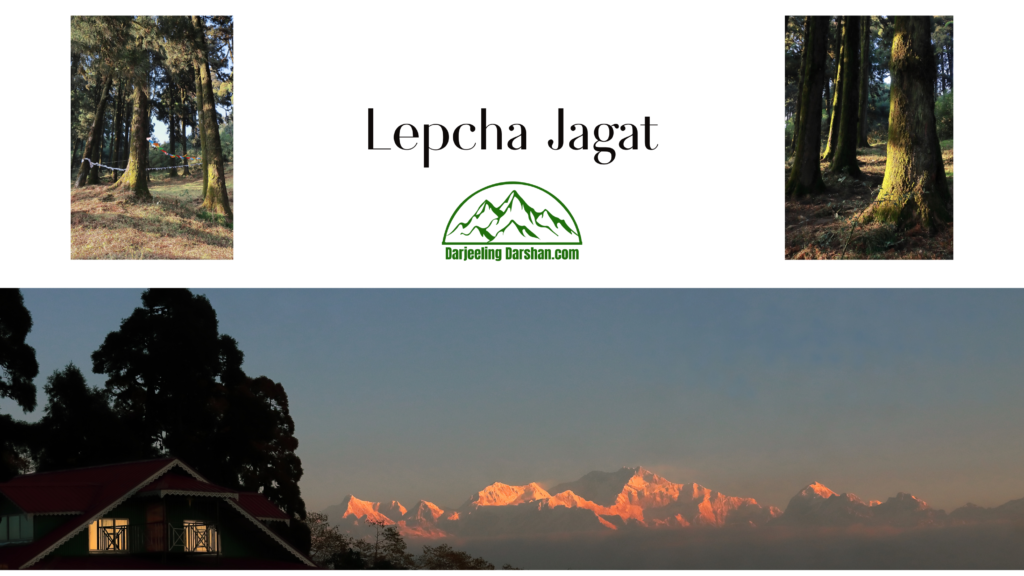
Lepchajagat, a tranquil hamlet, lies just 19 kilometers from Darjeeling town. Pine and rhododendron forests surround this secluded retreat at 6,956 feet, showing spectacular Kanchenjunga views without the crowds. Nature lovers will love the pristine forest walks where Himalayan birds and small mammals roam freely in their habitat. The indigenous Lepcha tribe’s sacred area gives this place its name. Local homestays let you experience authentic hill culture and cuisine firsthand.
Lamahatta Eco Park: Nature’s balance
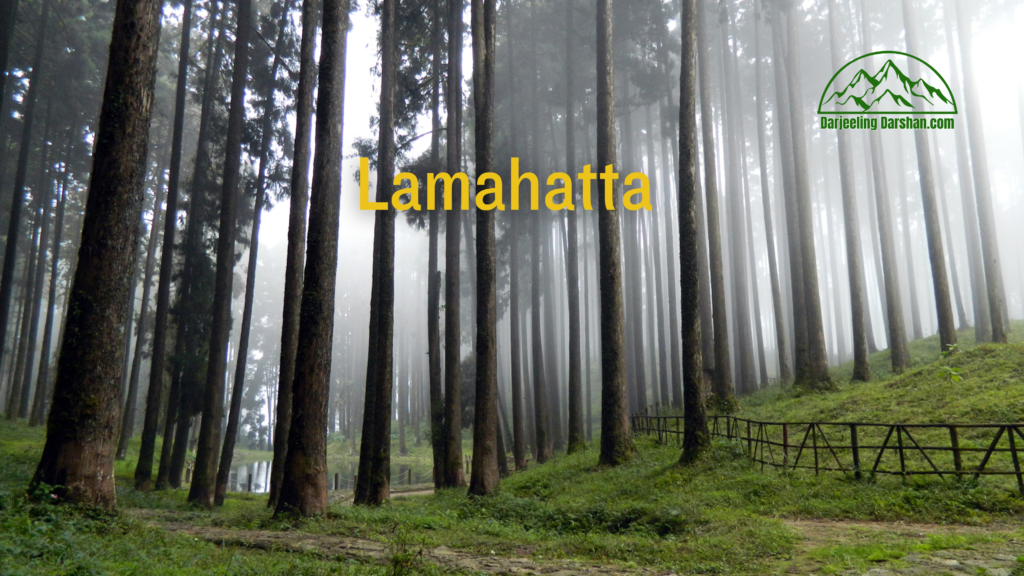
Lamahatta Eco Park stands 23 kilometers from Darjeeling on the Kalimpong route. This community-based tourism spot showcases bamboo gazebos, meditation spots, and prayer flags that create a spiritual atmosphere. Mountain panoramas stretch out before you from the central viewing point. The park stays relatively quiet even during peak season. Local guides share stories about native plants and environmentally responsible methods used here.

Learn why Lamahatta pond is also known as “Sacred Pond”?
Chowrasta: The heart of local life

Chowrasta’s cultural importance often goes unnoticed by visitors despite its central location. This flat, open square serves as Darjeeling’s social center where locals meet daily. The square has been the town’s pulse since colonial times. You’ll discover around the square:
- Nehru Road with its colorful shops selling Tibetan artifacts.
- The century-old Oxford Bookstore.
- Traditional tea stalls serving authentic Darjeeling varieties.
People-watching at Chowrasta shows real local life as elderly residents chat while children play nearby.
Dali Monastery: A peaceful retreat
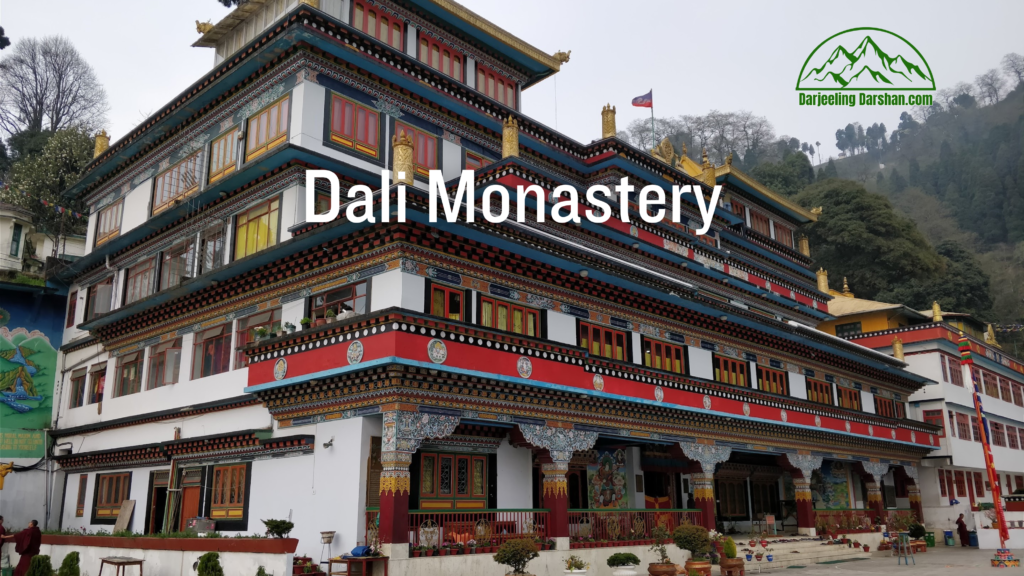
Dali Monastery (officially called Druk Sangag Choling Monastery) offers a truly peaceful experience compared to the busier Ghoom Monastery. This Kargyupa sect monastery, founded in 1971, houses over 300 monks and features remarkable thankas (Buddhist paintings) and a 15-foot Guru Rinpoche statue. Visitors can watch morning prayer ceremonies where monks chant traditionally with musical instruments. The monastery’s architecture displays unique Tibetan design elements rarely seen in Darjeeling’s tourist spots.
Conclusion
Darjeeling is a paradise where nature, culture, and adventure blend naturally. Our trip included amazing sunrise views at Tiger Hill, the marvel of colonial engineering at Batasia Loop, and peaceful moments at the Peace Pagoda and Mahakal Temple. We also saw impressive conservation work at Padmaja Naidu Himalayan Zoological Park and found rich history at the Himalayan Mountaineering Institute.
This beautiful hill station has something for everyone. Adventure lovers can trek through Singalila National Park or take the historic toy train ride. People looking for peace can walk through emerald tea gardens or meditate at the Japanese Peace Pagoda. Places like Lepchajagat and Dali Monastery offer authentic experiences away from regular tourist spots.
Darjeeling’s magic goes beyond its attractions – it’s about how these places touch your soul. The morning light on Kanchenjunga’s snow-capped peaks makes time stop. The fresh tea leaf aroma at Happy Valley Estate creates lasting memories.
Your visit’s timing is vital because weather affects the experience. The clearest views and best temperatures come during October to November and March to May. Each season shows its charm differently – monsoons bring green landscapes while winter sometimes covers everything in soft snow.
Planning a trip to this Himalayan paradise? Note that Darjeeling’s beauty extends beyond what words can describe. The warm locals, steaming cups of world-famous tea, and the peace that fills these hills need personal experience to understand. Darjeeling gives you more than sightseeing – it turns visitors into storytellers.


What a guide! It will help our family a lot to their Darjeeling trip ❤️❤️
Thank you for your guidance l.
Loved Darjeeling
Thank you very much and for your support